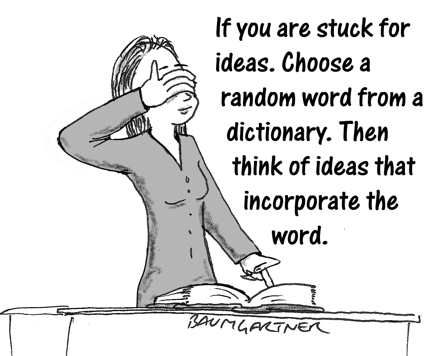
Nine creative thinking tips that use diversity
By Jeffrey Baumgartner
Are you ever stuck for an idea? If so, read on. We're going to look at a few things you can do to inspire creative thinking when when you need ideas. But first, let us agree on what constitutes a creative idea.
A creative idea is two or more existing ideas (I like to call these existing ideas, 'notions') that are combined to create something that is novel and unconventional. Usually, these notions need to be diverse enough that no one has previously combined them. For instance, a combination of not-very-sticky glue, small sheets of paper and leaving messages resulted in the idea of Post-It notes. The combination of mobile phone, digital camera and sharing with friends resulted an idea that has since led to nearly every mobile phone today having the functionality to take pictures.
So, if you want to build creative ideas, you simply need to diversify your thinking. Here are nine tricks for doing so. You are probably familiar with some of them.
1. Random word
Random word selection is one of the oldest, easiest and most effective creativity tips ever. I believe Edward De Bono came up with it, but I am not sure (if you know the origin, please let me know).
It works like this: if you are stuck for an idea, just open a dictionary or another book (some people swear by the complete works of Shakespeare), close your eyes and jab at the page. Open your eyes and look at the word you've selected. Now, try to come up with ideas that incorporate that word. If you've never tried this method, try it. I guarantee you will be surprised by the results and, if not, send this issue of Report 103 back to me for a full refund!
Google Variation
The Google variation of random word is to put into the Google search field key words about your situation together with a random word and then hit search. Be inspired by the results. The Google variation feels more modern, but I feel it is less effective than random word.
2. Prohibit boring ideas
In anticonventional thinking (ACT) sessions, I often put up a "Boring Ideas Prohibited" sign and make it clear that I will not tolerate boring ideas. This is because, for most people, the natural state of idea generation is to think conventionally and combine conventional, non-diverse thoughts to build ideas. By prohibiting conventional ideas, you push people to think more diversely.
If you are trying to come up with ideas on your own, you probably do not need a sign. Just make it a rule not to waste time on boring ideas. Reject them as soon as they come to mind.
You can take this trick one step further, especially if you or your team seem to be coming up with too many conventional ideas in spite of the prohibition. Make a "Boring Ideas" list and put conventionals idea on it. Then look at each of those ideas and try to work out what would be its opposite.
3. Talk with a non-expert
When you need ideas for a situation that is specialised to some degree, talk about the situation with someone who has no expertise in the subject matter. For instance, if you are working on a software project, talk about it with someone who is not knowledgeable about software. She will have a completely different perspective on the situation than you and your colleagues do. To her, software is probably something she uses regularly without understanding how it works and that leads to very different perspectives than a software engineer would have.
Explain the situation and your goal. Listen and take notes of her questions as well as any ideas she offers you. Her ideas will probably not be the entire solution. But her non-expert interpretation of your situation, combined with your expert knowledge can provide the diversity you need to build creative ideas.
4. Create a diverse team
If you have the wherewithal to put together a team to work on a problem, make the team as diverse as possible. Get people with different backgrounds, skin colours, nationalities, sex and age. Bring in at least one person with little expertise in the situation.
Such diversity in team members leads to diversity in thinking and execution. The result is almost guaranteed to bring creative results. And, if the team still gets stuck for ideas, try one of the other tips in this article.
5. Build a model
In business, most people verbalise problems rather than visualise them. You shout out ideas in brainstorms, you type ideas into idea management software and you talk about ideas in meetings.
Limiting your perspective of a situation to words also limits your thinking. Try making a model of your situation instead. This could be in the form of pictures. It could be in the form of something made with paper, glue, string and other craft materials. It could be a sophisticated technical model built by a specialist shop.
Even abstract ideas can be put into models. Working on internal communications? Instead of talking about it, buy some toy figures (for example: Fisher Price Little People or Lego Minifigures) and set them up with little desks and conference tables and other office furniture. Move them around. Play with them. Find ideas visually.
Simply changing your perspective on the problem from one of language to one of visualisation brings a lot of diverse thought. Moreover, playing with situations and ideas is probably the most powerful creative thinking technique known to the human race.
6. Criticise ideas
Unfortunately, many creativity pundits believe that criticising ideas is wrong and spoils creativity. But it is they who are wrong. Not criticising ideas tells people that all ideas, even conventional ones, are good ideas and so discourages people from being more diverse in their thinking. Steve Jobs did not revolutionise mobile telephones, MP3 players and other products by complimenting every idea and saying it was fine and dandy. No. He famously was highly critical in a way that pushed people to reject conventional thinking and make diverse, unconventional connections that led to many of Apple's products today.
Of course you need to criticise ideas in the right way if you want to inspire creativity. That involves three things. Firstly, you need to respectfully criticise ideas, making it clear that you respect the thinking, you respect the person even more and you are sure she can do better.
Secondly, you need to criticise ideas in ways that lead to more diversity of thought, not less diversity of thought. For example, if Alice shares a rather dull idea, don't say, "That's a dull idea, Alice." Instead, say, "I like your thinking, Alice, but we both know you can be more creative than that. Push your thinking further!"
Thirdly, you need to see potential pitfalls as challenges, not obstacles. Do not say, "That idea would never work; it would take a year to complete and we only have three months." Instead, say, "If I understand your thinking, it would take us a year to complete your idea. We only have three months. How can we modify your idea to meet our schedule?" Absolute obstacles discourage creativity. Challenges encourage it.
7. Go for a walk
Going for a walk is a great way to allow your mind to wander which leads to great thinking. When your mind wanders, it makes more diverse connections than it does when you are focusing on a problem or in a work environment.
In addition, movement, visual stimulation, smells and noises can all be absorbed and inspire diversity of thought. For me a walk is the single most powerful creative thinking technique I know.
8. Talk to a creative friend or colleague
Some people do not need to make an effort to think diversely. They are natural creative thinkers. You probably know people like that. They are always coming up with ideas, although some of those ideas may be ridiculous. They tend to have a sense of humour and are often perceived as eccentric or rebels. Just as you would ask an expert for advice, ask a really creative person for ideas. She will almost certainly be delighted to help. Creative people love creative challenges.
Her ideas might not be perfect, but you can probably tweak them to make them work.
9. Put the situation on the back burner
If ideas will not come, put the situation on the back burner and work on something else. Trying too hard to come up with ideas tends to focus your mind intensely and that leads to focused thinking rather than diverse, unconventional thinking. So, if ideas do not come, let go of the situation. Doing other, unrelated things while the situation lurks in the back of your mind will allow your mind to bring new associations to the situation. Perhaps a conversation on a completely different issue will spark a connection. Perhaps listening to a colleague talking about a seemingly unrelated situation causes you to realise that her situation is not as unrelated as you think. You may be able to apply a modified version of her approach to your situation.
Anything that brings in new stimulation
As we have seen, any action that brings in new and diverse stimulation makes it easier for your mind to make associations with seemingly unrelated issues and those associations can quickly become creative ideas. So, the next time you are stuck for ideas, try one or more of my suggestions and let me know how it works for you.
Have you got any creative thinking tips? If so, share them with me! I'd love to hear from you.
Recent Articles
Leading Diverse Teams
Filed under: Business Innovation
Diverse teams are more innovative and smarter than homogeneous ones. But, they are also harder to manager. Here are some tips. By Jeffrey Baumgartner -- Read the article...
Questions you should ask when an innovative project fails
Filed under: Business Innovation
You can learn a lot from the failure of an innovative project, but you need to ask the right questions. Here are those questions. By Jeffrey Baumgartner -- Read the article...
Unmarketing the Competition
Filed under: Business Innovation
A look at creative, but unethical dirty trick marketing campaigns designed to damage the competition By Jeffrey Baumgartner -- Read the article...
Imaginativefulness and the Fisherman
Filed under: Creativity
What does a fisherman wearing a cycling helmet have to do with imaginativefulness? Quite a lot, it seems. By Jeffrey Baumgartner -- Read the article...
Actually, Criticising Ideas Is Good for Creativity
Filed under: Creativity
People have long assumed criticising ideas in a brainstorm inhibits creativity. Research and experience shows that is wrong By Jeffrey Baumgartner -- Read the article...
Imaginativefulness
Filed under: Creativity
Imaginativefulness is a state of heightened imagination in which your mind allows thoughts, memories and ideas to play with each other freely. By Jeffrey Baumgartner -- Read the article...
Why and How to Exploit Alternative Uses for Your Products
Filed under: Business Innovation
Discovering new ways customers use, misuse and could use your products can inspire innovation. Jeffrey Baumgartner explains. By Jeffrey Baumgartner -- Read the article...
The Cost of Not Innovating
Filed under: Business Innovation
If your company fails to innovate, you pay a steep price in terms of loss of leadershop, tight margins, missed opportunities and more. By Jeffrey Baumgartner -- Read the article...
Don't Trust the Status Quo
Filed under: Creativity
Jeffrey Baumgartner has never trusted the status quo. He explains why this is so and why you should also not trust the status quo By Jeffrey Baumgartner -- Read the article...
Index of all creative articles...




